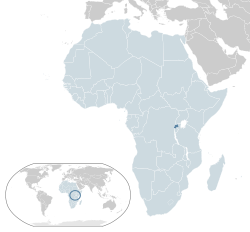မိူင်းရဝၢၼ်းတႃႇ
Appearance
| မိူင်းၸွမ်ပွင်ၸိုင်ႈ ရဝၢၼ်းတႃႇ | |||||
|---|---|---|---|---|---|
| |||||
|
ၶေႃႈၶၼ်ပၢၵ်ႇ: "Ubumwe, Umurimo, Gukunda Igihugu" "Unity, Work, Patriotism" | |||||
 ဢွင်ႈတီႈ မိူင်းရဝၢၼ်းတႃႇ (သီသွမ်ႇၵႄႇ) – Africa ၼႂ်း (သီသွမ်ႇၼုမ်ႇ လႄႈ ၶွၼ်ႇၵႄႇ) | |||||
| ဝဵင်းငဝ်ႈၸိုင်ႈ လႄႈ ဝဵင်းယႂ်ႇသေပိူၼ်ႈ |
Kigali 1°56.633′S 30°3.567′E / 1.943883°S 30.059450°E | ||||
| ၽႃႇသႃႇၵႂၢမ်း ၸႂ်ႉၼႂ်းလုမ်း | |||||
| မဵဝ်းမိူင်း | မိူင်းၸွမ်ပွင်ၸိုင်ႈ | ||||
| လူင်ပွင်ၸိုင်ႈ | |||||
• ၸွမ်ပွင်ၸိုင်ႈ | Paul Kagame | ||||
• ၸွမ်ၽွင်းလူင် | Édouard Ngirente | ||||
| တႄႇတင်ႈ | |||||
• လွတ်ႈလႅဝ်းသဝ်းၶေႃ (တီႈ ပႄႇၵျီႇယႅမ်ႇ) | 19622၊ ၵျူႇလၢႆႇ 1 | ||||
| ႁူဝ်ၼပ်ႉၵူၼ်း | |||||
• 2019 လၢမ်း | 12,374,397[1] (ၸၼ်ႉ - 76th) | ||||
• 2012 သဵၼ်ႈမၢႆႁူဝ်ႁိူၼ်း | 10,515,973[2] | ||||
• လွင်ႈသတ်ႉႁူဝ်ၼပ်ႉၵူၼ်း | (ၸၼ်ႉ- 22nd) | ||||
| GDP (PPP) | လၢမ်း 2019 | ||||
• ႁူမ်ႈ | $30.068 billion | ||||
• Per capita | $2,444[3] | ||||
| GDP (nominal) | လၢမ်း2019 | ||||
• ႁူမ်ႈ | $10.211 billion | ||||
• Per capita | $830[3] | ||||
| Gini (2016) |
43.7[4] ၵၢင် | ||||
| HDI (2018) |
0.536[5] တႅမ်ႇ · 157th | ||||
| ငိုၼ်းတွင်း | Rwandan franc (RWF) | ||||
| ၶၢဝ်းယၢမ်းၼႃႈလိၼ် | CAT (UTC+2) | ||||
| ပိူင်သၢႆလူတ်ႉ | မိုဝ်းၶႂႃ | ||||
| ၶူတ်ႉတႄႇလီႇၾူင်း | +250 | ||||
| Internet TLD | .rw | ||||
ၽိုၼ်ဢိင်
[မႄးထတ်း | မႄးထတ်းငဝ်ႈငႃႇ]- ↑ National Institute of Statistics of Rwanda (2019). Size of the resident population. National Institute of Statistics of Rwanda. Retrieved on 4 April 2020။
- ↑ National Institute of Statistics of Rwanda 2014, p. 3.
- ↑ 3.0 3.1 Report for Selected Countries and Subjects.
- ↑ World Bank (XII).
- ↑ Human Development Report 2019 (PDF) (in en). United Nations Development Programme (10 December 2019). Archived from the original on 30 April 2020။ Retrieved on 10 December 2019။


